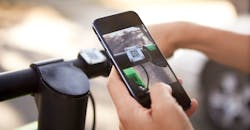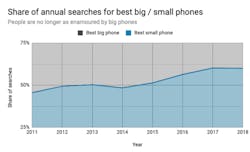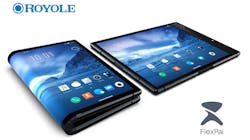How Waterproofing Will Change the Smartphone Design Paradigm
“Every Smartphone Is Boring: Where Are The Radical Designs?” This is a Forbes headline from 2015, and while it’s not the first to state this, little has changed in the years since then. The subject has been repeated at virtually every Mobile World Congress. For example, last year the BBC asked “Why do smartphones look so alike?”
And it’s not hard to see why. Take a look at any of the big brands’ recent handsets and a fairly consistent theme can be seen: A large rectangle, with as much screen as possible, and (if high end) packaged in a perfectly sealed casing.
But is this what customers want?
Google Trends suggests not, with the proportion of searches for the “best small phone” out-accelerating those for the “best big phone” since 2014. Searches for “beautiful phone” are also increasing quickly, rising 200% since the start of 2010, suggesting people want something more interesting (Fig. 1).
1. Google search trends for the terms “best big” and “best small” phone reveal a smaller proportion of people want big handsets—from an even split in 2014 to more than 60% of searches being for small handsets in 2018. (Source: P2i)
As for design differentiation, arguably the hottest phones of late have been the Samsung Galaxy S8 and S9, which dared to be different with a curved screen and virtually no bezel. To quote TechRadar, the Galaxy S8 is “a triumphant mix of tech and design.”
At last year’s MWC, there were a smattering of different designs. Of note was Lenovo’s foldable handset prototype that turned into a smartwatch. But these were exceptions.
We’ve come a long way since companies dared to be different. Think back to iconic designs such as the Motorola Razr, v70, or the Nokia 8110 (made famous by The Matrix), or even the classic clamshells (Fig. 2). Even post iPhone, handsets were once unique, with Apple even suing Samsung for mimicking the iPhone’s casing design. These days seem long gone.
2. Two iconic designs: the Samsung Galaxy S9 (a) and Motorola Razr (b). A foldable smartphone version of the Razr is rumored to be in development. And manufacturers are returning to classic designs, e.g. Nokia’s 8110 sliding “Matrix” phone.
Waterproofing Tech Has Limited Design Differentiation
According to a recent YouGov survey, the three most important features on a handset are longer battery life, an unsmashable screen, and a waterproof design. In short, the three things that let you keep using a very expensive device and avoid costly insurance bills, repair costs, or replacements.
Every day, over 900,000 handsets are damaged by water. This is reflected in a 2017 Morning Consult survey of people that would consider buying the Samsung Galaxy S8. Respondents placed the device’s water protection as the feature most likely to sway their purchase decision.
But waterproofing technologies also affect the design of the handset, with mechanical seals and gaskets only being effective on simple (i.e., square) designs. Indeed, foldable, flexible, or curved designs are a challenge, and other design implications—such as allowing an easily replaceable battery—are prevented. In the iPhone, even the headphone jack has been removed.
And because of an increased bill of materials (BOM) and the cost of mechanical seals, water protection can only be rolled out on the most expensive handsets. This means square designs becomes synonymous with expensive, and lower-cost handsets follow suit to copy that square design to avoid looking cheap.
The Desirability of Water Protection is Set to Rise
Early smartphones could be differentiated by the features they included, but they now all run powerful-enough processors to perform any app or task requested. Virtually all of them have exceptional cameras in the front and back; the same goes for GPS, Bluetooth and Wi-Fi, and any other feature. There’s little to differentiate the phone anymore, making the design aesthetics essential.
And while the rise of 5G will mean a new desirable feature, this will be quickly adopted by all brands. Therefore, the only differentiation OEMs will be able to gain from this technology is how they design to cope with 5G chipset power demands and thermal dissipation.
Furthermore, because of the rise in cost wrought by 5G, handset lifetimes are expected to increase. Canalys has stated that in North America the average handset life expectancy will increase by 15.6% (from 22.5 months in 2017 to 26 in 2022). Smaller, but significant, rises will happen elsewhere—5.1% in Europe (29.4 to 30.9) and 5.0% in Asia Pacific (30 to 31.6). And with this increased device life comes an greater chance of damage, and therefore an increased need/desire for water-protection technologies.
Evolution of Waterproofing Technology
The irony of all this is that waterproof seals fail quickly. Sealing tape will delaminate quickly. And the second that the screen or casing is cracked, following an accidental drop, then water can enter the device.
Research by Motorola estimates that a fifth (21%) of smartphone owners currently have at least one smartphone with a cracked screen. Of these, 43% of these won’t repair it... 23% won’t even do so when the crack is bad enough to cut them.
Added to this are claims by Motorola Care that the average time from a phone’s purchase to breaking is just 10 weeks. And we’ve been told by repair centers that approximately 15% of IPX8 devices fail air-pressure tests within just two weeks of activation. However, the technology is evolving.
While hydrophobic nano coatings have been around for a few years, these typically protect the outer casing, and normally only to IPX2. Recent advances have adopted thicker nano coatings to protect the PCB, but again this only improves protection to IPX4 or IPX5 levels.
So, when water enters through a cracked screen, only the PCB will have this level of protection—the circuitry of other components can still receive water damage. So, every effort is needed to stop water getting in.
However, 2019 will see even more advanced offerings hit the market, with multi-chemistry techniques used to deliver system-level protection (such as P2i’s Dunkable). These technologies will increase protection up to IPX8, and even enable a handset to run underwater for significant periods, with exposed electronics being unaffected.
Will We See More Diverse Designs in 2019?
At last year’s MWC, Carolina Milanesi, a consumer technology analyst at Creative Strategies, told the BBC: "Hardware is always the easiest thing to sell—if it looks different, you get the consumer’s attention, and then you build from there. Trying to get someone into a store for something that looks the same as last year is difficult, even if it has new things to offer."
Apple, and in particular its head designer, Sir Jony Ive, has shown bold and original designs can play a vital role in success. This is backed up by the growing number of people searching for the term “beautiful phone” and the sales figures for Samsung’s Galaxy S8/S9 with the curved-edge screen being a key advertised feature.
So, with the implementation of system-level waterproofing, I think the first thing we’ll see (starting in 2019 and into 2020) will be the move to virtually eliminate the bezel, enabling smaller handsets for the same size screen.
At the same time, the thermal dissipation and power requirements of 5G chipsets will require space freed for larger batteries without increasing the size of the device. We may see bold thermal-management features brought into the design of the handset casing. Vents even?
3. Royole launched the first folding smartphone last November, with Samsung, LG, Motorola, and Huawei all said to be developing similar models. Will such designs become more common? (Copyright Royole PR)
After that, the move to flexible screen technologies (Fig. 3) will, I think, start to be adopted more widely. Flexible/foldable devices was a key topic of discussion at CES 19. The first foldable phone, Royole’s FlexPai, is already available. Samsung, LG, and Huawei are said to be developing such handsets. And Motorola is rumored to be creating a folding smartphone version of the Razr, which if initial reports are right, will be stunning.
It should be noted that, as well as being flexible, the makers of these plastic screens claim they’re less prone to cracking than Gorilla Glass. Also, the emergence of flexible OLCD (rather than OLED) technologies should make them affordable to implement.
Finally, I think the consumer’s increasing desire for smaller phones (as shown by Google searches), coupled with the need for smartphones to have as large a screen area as possible, will bring with it the return of the clamshell... However, this time it will be with two edge-to-edge UHD screens that can present video content on a much bigger widescreen display, while still fitting comfortable into the user’s pocket.
About the Author
Ady Moores
CEO
Ady Moores is CEO of P2i, a leading developer of waterproofing technologies for the electronics sector.




